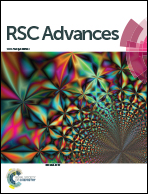Nucleophilicity of normal and abnormal N-heterocyclic carbenes at DFT: steric effects on tetrazole-5-ylidenes†
Abstract
Nucleophilicity (N) is a crucial factor for the coordination of N-heterocyclic carbenes (NHCs) to transition metal complexes. In this work a comparison is made between N of a series of 1,4-disubstituted, “normal”, tetrazol-5-ylidens (1R), and their corresponding 1,3-disubstituted, “mesoionic, or abnormal”, isomers (2R), at the M06/6-311++G** level of theory; where R = H, methyl, ethyl, i-propyl, and t-butyl. Every abnormal 2R appears more nucleophilic than its related normal 1R isomer. Similarly, every 2R (except 2methyl) emerges as more aromatic than its corresponding normal 1R isomer. In addition, N increases as the size of the substituent increases. The global electrophilicity (ω) trend takes on an exactly opposite direction. Stabilities of 1R and 2R carbenic species are presumed to be related to their singlet–triplet energy gaps (ΔES–T, kcal mol−1). Every normal 1R appears more stable than its corresponding abnormal 2R isomer. The most stable is 1ethyl in the normal and 2ethyl in the abnormal series. The least stable are 1methyl and 2methyl structures, respectively. Lower stability of the latter two species is attributed to their relatively lower NICS, higher proton affinity (PA), higher aptitude for dimerization, wider carbenic bond angles (N–Ĉcarbene–N), and longer Ccarbene–N bond lengths. Interestingly, the charge on carbenic carbon is the highest for 1t-butyl and lowest for 2t-butyl. Every normal 1R shows a wider band gap than its corresponding abnormal 2R, for showing a larger ΔEHOMO–LUMO. Finally, due to the steric effects, 1t-butyl does not dimerize, while all other normal 1R carbenes, as well as abnormal 2methyl give doubly bonded dimers (head-to-head).


 Please wait while we load your content...
Please wait while we load your content...